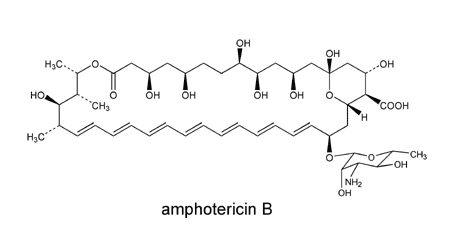Manufacturer’s Prescribing Information
Trade & Generic Names & General Features
Amphotericin B is a polyene antifungal agent, first isolated by Gold et al from Streptomyces nodosus in 1955. It is an amphoteric compound composed of a hydrophilic polyhydroxyl chain along one side and a lipophilic polyene hydrocarbon chain on the other. Amphotericin B is poorly soluble in water [2232].
Amphotericin B is now available in four formulations. The classic amphotericin B deoxycholate (Fungizone™) formulation has been available since 1960 and is a colloidal suspension of amphotericin B. A bile salt, deoxycholate, is used as the solubilizing agent.

This preparation has a number of toxicities that are partially ameliorated when a lipid carrier is used. Thus, three lipid preparations of amphotericin B have been licensed and are currently available [1044]. These are:
Amphotericin B Colloidal Dispersion (ABCD; Amphocil™ or Amphotec™)
Amphotericin B Lipid Complex (ABLC; Abelcet™)
Liposomal Amphotericin B (L-AMB; Ambisome™)
Susceptibility patterns, usual doses, side effects and current status reviewed on this page are of the conventional amphotericin B formulation, unless otherwise is noted. For detailed information on these issues for the lipid formulations, refer to the corresponding page(s).
Mechanism(s) of Action
Amphotericin B binds to sterols, preferentially to the primary fungal cell membrane sterol, ergosterol. This binding disrupts osmotic integrity of the fungal membrane, resulting in leakage of intracellular potassium, magnesium, sugars, and metabolites and then cellular death. The mechanism of action is the same for all the preparations and is due to the intrinsic antifungal activity of amphotericin B [2232].
Susceptibility Patterns
A standard method of NCCLS is available for testing in vitro susceptibility to amphotericin B [1622, 1623]. However, it lacks ability to readily discriminate the resistant isolates from the susceptible ones. While some investigators have reported the use of Antibiotic Medium 3 to be useful in this respect [1379, 1905], data obtained in other studies do not always support this theory [1639]. Using various modifications of the NCCLS methodology, moderately strong correlations between MIC and/or MLC (minimum lethal concentrations) and outcome have been reported [445] [1639].
Generally speaking, amphotericin B has a very broad range of activity and is active against most pathogenic fungi. Notable exceptions include Trichosporon beigelii [2365], Aspergillus terreus [2203], Pseudallescheria boydii [2353], Malassezia furfur [755], and Fusarium spp. [119].
On occasion, however, isolate of any species may be found to be resistant. Among the Candida spp., isolates of:
- C. albicans,
- C. guilliermondii,
- C. lipolytica,
- C. lusitaniae,
- C. norvegensis,
- C. tropicalis,
- C. glabrata, and
- C. krusei
have been reported to be relatively resistant to amphotericin B [1156, 1157, 1527, 2232]. Reduced susceptibility has been observed specifically at fungicidal levels for C. parapsilosis [2074].
For amphotericin B MICs obtained for various types of fungi, see susceptibility patterns and the N/A(L):susceptibility database.
Usual Doses
Amphotericin B deoxycholate is administered by intravenous infusion at doses ranging from 0.3 to 1.5 mg/kg and over 1-4 h [1527, 1685].
Side-Effects
The most commonly observed infusion-related side effects of amphotericin B deoxycholate are fever, chills, and myalgia. These can be partially overcome by premedication with diphenhydramine and/or acetaminophen [873].
Nephrotoxicity is the major adverse effect limiting the use of amphotericin B. The manifestations of nephrotoxicity are azotemia, decreased glomerular filtration, loss of urinary concentrating ability, renal loss of sodium and potassium, and renal tubular acidosis [1527]. The renal injury reduces erythropoietin production and leads to a normochromic normocytic anemia [1346].
Thrombophlebitis may occur at the site of infusion. Thrombocytopenia may rarely be observed [413].
Amphotericin B and its lipid formulations are administered intravenously.
Amphotericin B still remains as the mainstay of antifungal therapy. Its lipid formulations, on the other hand, are promising due to their ability to reduce the toxicity of amphotericin B. They are currently licensed for use when amphotericin B therapy fails or is unacceptably toxic. The use of lipid formulations in specific clinical settings is under continuing investigation [2454].
Please also see our discussion on cost analysis and pharmacoeconomic analysis of antifungal therapy.
